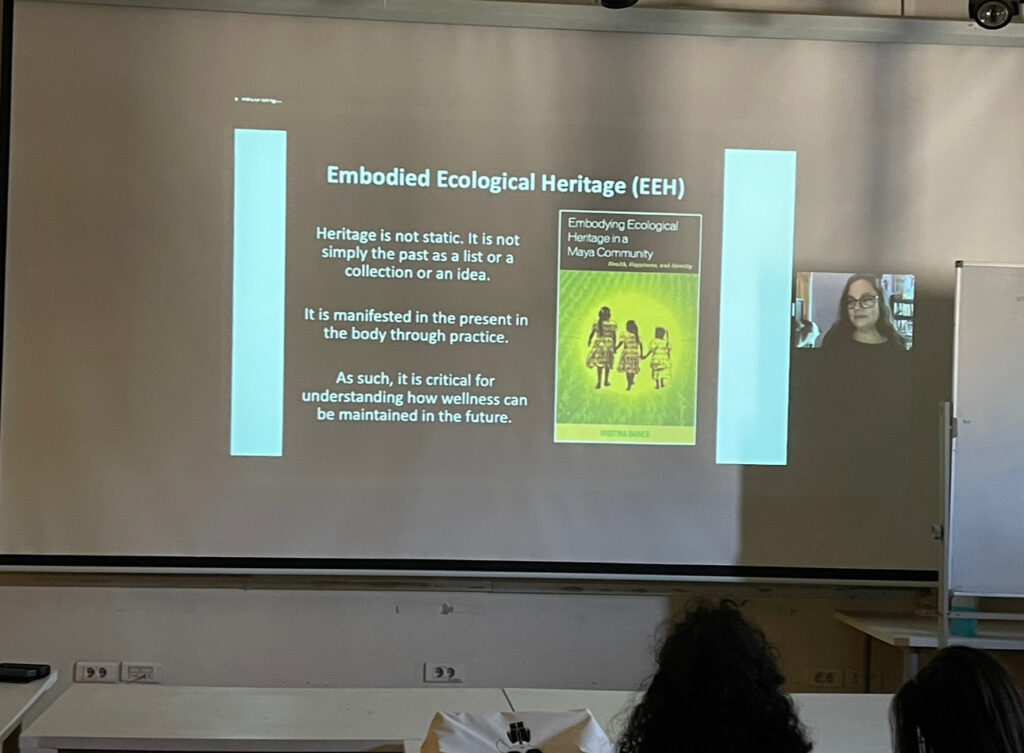Professor: Kristina Baines, Ph.D.
Course: SOCI 231 – Introduction to Urban Community Health
Modality: Hybrid
Partner Institution: American University Of Cairo


Abstract of Project: This project engages students from AUC and CUNY to investigate the urban-health challenges facing university students when accessing spaces related to physical and mental health at AUC (Cairo) and Guttman CUNY (NYC). Using online platforms for virtual exchange, students build a comparative analysis of how spatial, social and economic inequalities in campuses are constructed similarly and/or differently in both contexts. Semi-structured interviews, questionnaires, non-participatory observation, community focused groups, photos of the built environment together with mapping and visual graphics will be used to analyze, synthesize and propose solutions. The project addresses the United Nations’ SDG10 that emphasizes the importance of reducing inequalities within and among countries. The experiential learning project is twofold. First, it is a cross-cultural experience with group-work and teams created across the Atlantic between the global north (US) and the global south (Egypt). Secondly, students are challenged to explore the inherited social, economic and spatial registers facing university-campuses when dealing with the pandemic and turbulent uncertainties at each respective community. At Cairo, students will explore students’ usage of open spaces and health-related facilities to maintain physical and mental health. At New York City, students will explore the utilization of open spaces and health-related facilities at Guttman College – CUNY in mitigating Non-Communicable Diseases (NCDs). At the end of the semester, both classes at AUC and Guttman College will participate in a student conference to disseminate their findings.
Inquiry-based questions for design:
1) At times of pandemic, and beyond, what are the urban design elements for a healthy, inclusive and earthly- responsible college town to be developed at Cairo’s desert environment?
2) How is SDG10 related to urban-health issues, depicted across universities campuses of AUC (Cairo) and Guttman CUNY (NYC)? What are the similarities and differences for the different students’ groups across class, race and gender between the two cities and the study-groups of the two courses (AUC vs CUNY-Guttman) in terms of accessibilty to spaces of working-out, fitness, physical activity, sports, mental health, relaxation and meditation?
3) How to stimulate the mind, body and soul of a student community when creating a healthy college town?
Crafting the Project with Professor Partner: It was a great experience! Momen and I really saw eye to eye about the vision for healthy campuses and student research.
Student Engagement During the Partnership: Their engagement was mixed. Some embraced it but others felt it was harder to engage and were slightly intimidated by the Egyptian students.
Student Communication During the Project: Students communicated on Slack and worked collaboratively on google docs and google slides for their presentations.
Biggest Obstacles Faced: Both the differences in time zones and different semester timelines were challenging (a Fall semester collab would be easier at Guttman), in addition to the differences in student level, posed challenges for synchronous communication. Additionally, my partner in Palestine had to pull out of the project last minute so this collaboration, while still fruitful, was quite last minute and the assignments could have been better integrated.
Evaluating Success: Overall, the collaboration went well. Prof El Husseiny offered my students a new and helpful perspective on design for mental health, and I felt I offered the AUC students a unique perspective on thinking about health holistically. Some students really embraced the relationships with the AUC students even if others found it challenging to connect in a meaningful way. The social aspects of the connections seemed to rise above those of the research project, which was less integrated than was ideal.
Class Syllabus:
SOCI231_Spring1_2022_Syllabus_BainesKey GSACS Assignment:
Our investigation centered on 2 major assignments:
Research project: As part of a larger research project, you will conduct short free list interviews and digital pile sorts in your friends/family/community to assess how people are defining health and if that has changed since the beginning of the COVID-19 pandemic. Details on the research protocol are available in the modules. You will also collaboratively develop interview questions with AUC students and conduct interviews with college students related to health.
Community health resources mapping: You will investigate and assess the health resources and barriers in your community and create a map. This can be created digitally or on paper and photographed for submission. Details are available in the module.


